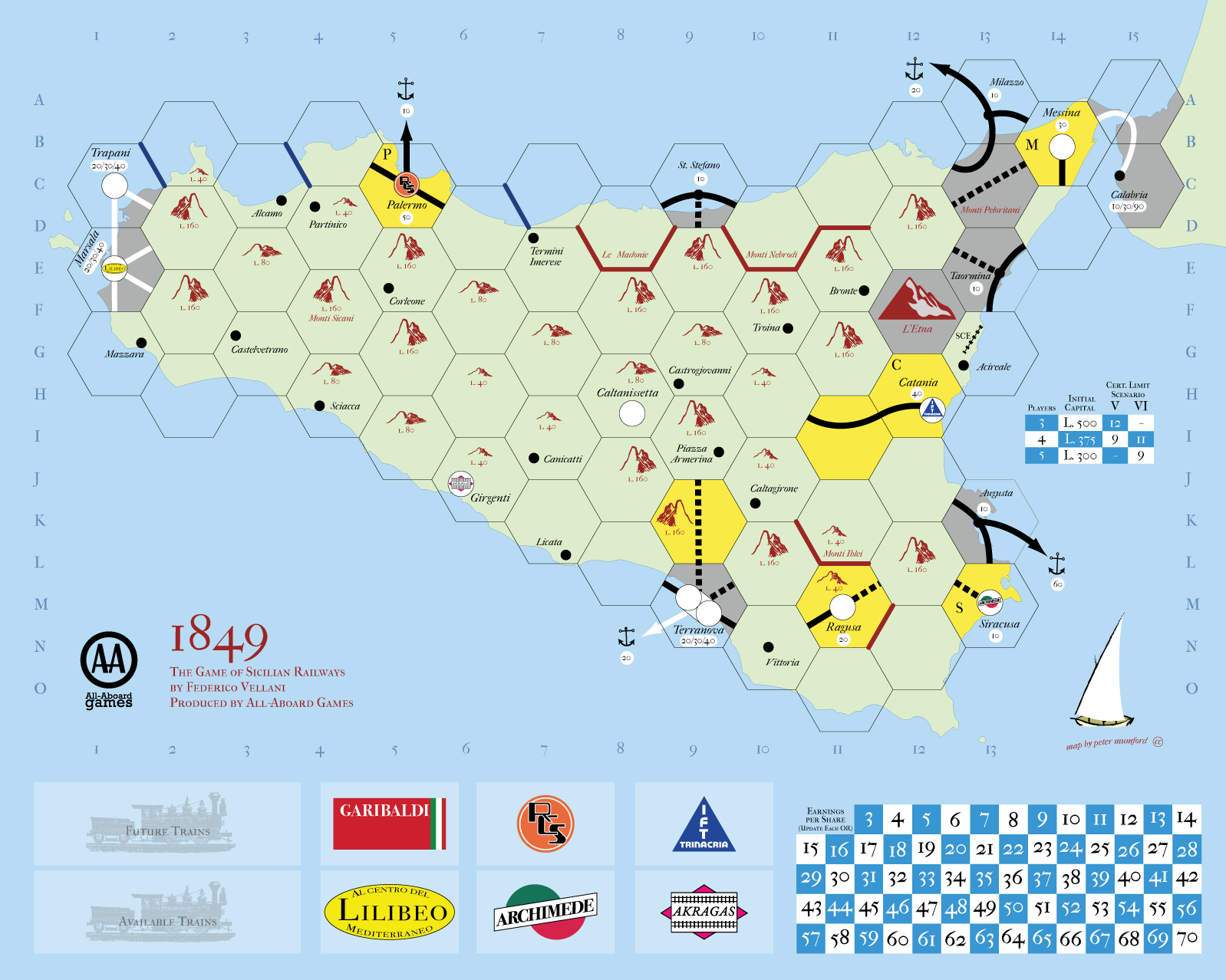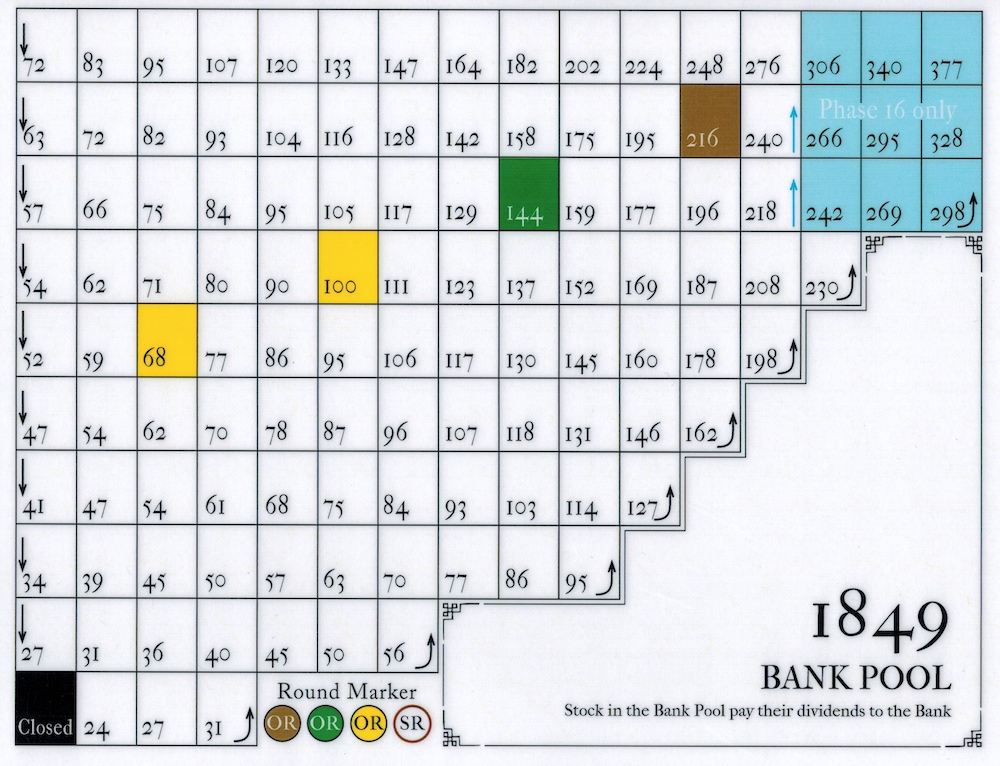Using 1830 as your point of comparison to 1849, there will be a handful of jarring differences. In many ways, a better point of comparison would be 1846, but since I tend to teach new players 1889 or 1830, what follows is written with the 1830 player in mind. What follows is not comprehensive, but rather a list of the major differences. For a complete rundown, you can download the current set of rules and see for yourself (just be sure to ignore any advanced or optional rules).
The common theme to all of these rules differences is that, in 1849, everything is expensive. This is a not-so-subtle way of communicating to the players that they will need to come up with ways to suck money out of whatever corporation they can in order to survive. Winning isn’t so much about creating a well-functioning rail system as it is about outlasting the other players while the world crumbles around you. Fun!
The Map
The map for 1849 depicts the island of Sicily, and is dominated by a mountainous interior* and major cities around the coastline. There are many towns scattered throughout the map, which means smaller profits. On the eastern edge of the map you’ll find Mt. Etna. It is an impassible hex, but also plays an important thematic role in the late game. As soon as someone purchases the first 12H train, the volcano erupts, causing a catastrophic earthquake in Messina to the northeast. Finally, note the prevalence of solid bars dividing certain hex-sides (red for mountains and blue for coastline), which represent impassable terrain for purposes of laying track.
* Some of those spaces are properly labeled as “rough” or “hill” spaces, but it’s all mountains to me. The only difference is cost to build. On the other hand, at the top end we’re talking about $160 per hex — and that’s pretty steep.

Floating Corporations
There are six corporations in the game, and they are available to float only in a strict order determined randomly before each game. If you’d like to float a new corporation, you must float the next available corporation. You have no other choice.
When starting a new corporation, the procedure is quite different from that in 1830. Instead of buying stock one share at a time, you choose a starting price as normal.† However, you then purchase the President’s Share (20%) and up to two additional single shares (for up to 40% total) in a single block. All of this initial capital is placed in the company treasury, not the general bank. 1849 is a “partial capitalization” game, which means your new corporation does not receive all of its capital from the bank when it floats. Only by issuing/selling shares on a future turn does the corporation raise additional capital.
Finally, your newly floated corporation must pay for all of its tokens up front. Each corporation comes with three tokens, with prices that vary by corporation. The corporation purchases its tokens using funds from its newly created company coffer. The upside here, I suppose, is that you don’t have to pay for them when you want to place them on the map at a later time.
† There are no “par prices” in 1849. All purchases and sales are made at the current price listed on the stock market chart.
Track Gauges
There are two track gauges: standard and narrow. Technically, there is a third option, dual gauge, but it’s merely a combination of the two and acts as whichever gauge comprises your current length of run (i.e., when making a narrow gauge run, dual gauge counts as narrow, and vice versa). Standard gauge track is marked on the map with solid black lines, narrow gauge with dotted black lines, and dual gauge with solid white lines.
Standard gauge track works the same as in 1830. Narrow gauge track is a quarter of the cost to build when constructing a route through the mountains, but typically slower to traverse when running your trains.
Train Ranges
Trains are rated according to the number of hexes they can traverse, and not by the number of cities/towns they can reach. Thus, a 6H train can travel six hexes no matter if those hexes contain empty track or profit-making cities.
Trains may run on standard or narrow gauge track. When running on narrow gauge track, a standard train moves at half speed. Thus, the same 6H train counts each narrow gauge section as though it were moving through two standard gauge sections. You can mix and match gauges along a single run, but may only switch gauges at a station (i.e., a city or town).
There are no diesel trains in 1849. Instead, you may eventually purchase an R6H train. This train reverses the normal cost to move across different track gauges. In other words, the R6H train may move across six hexes’ worth of narrow gauge track, but only three hexes’ worth of standard gauge track.
Continuous Upgrade Costs
Hey, remember all those mountains? Well, they never really go away. When you upgrade track, you have to pay the terrain cost again. This remains true throughout the game, no matter how many times you’ve upgraded the same hex. As a mnemonic, make sure to use the included tokens to mark hexes with underlying mountains when green and then brown hexes become available.
Track Upgrade Restrictions
Tile upgrades in 1849 are semi-restrictive. What does this mean? In 1830, a corporation need only reach the hex where it is placing a tile upgrade (permissive). In 1849, it must be able to reach some new piece of track on the new tile, or it must be able to reach a city on the new tile that has an increased value after the upgrade (semi-restrictive). Keep in mind, the corporation does not need a train that can actually reach the new track, but rather a hypothetical diesel that could.
In practice, this is a minor difference. Don’t spend too much time worrying about it. If it bothers you, though, think about the rule like this: when you upgrade track, you have to help your corporation, not just hurt your opponent’s.
Payment of Revenue
When paying out revenue to the stockholders, unissued shares in the corporation treasury pay out to the corporation. Shares in the bank pool pay out to no one. This is the opposite of what happens in 1830, but sort of makes more thematic sense anyway.
Stock Appreciation
In 1830, you increase a corporation’s stock value every time it pays out revenue to the shareholders. Not so in 1849. Instead, you only increase the value (move the marker to the right) when the value of the revenue paid to the stockholders per share is greater than or equal to the current market value of the stock. I like to think of this as the stockholders demanding a better ROI.

Issuing Shares & Stock Buybacks
A corporation can float with as little as 20% of its stock in player hands. That’s not much capital upon which to build an empire, so a corporation is permitted to sell shares directly to the bank pool. When operating during any round after the corporation’s first operating round, you may issue shares to the bank pool as your final action of the turn. The sale price is the current market value; however, after completing the sale, you must move the stock price down one space per share issued (the same procedure as when someone normally sells shares). All funds are placed in the corporation’s treasury.
Similarly, a corporation is allowed to buy back shares in the bank pool. This is important because, after each stock round if a corporation has any shares in the bank pool, it’s stock price is reduced down by one space. You may not buy back shares if you sold them this round. Additionally, you may only buy back a single share per operating round.
Closing a Corporation
If a corporation’s stock price ever drops to the lowest position on the stock market (lower lefthand corner), that corporation immediately closes. Stockholders receive no compensation, all corporate money and tokens are returned to the bank, and all matching stock certificates are gathered up and placed at the end of the available corporations queue. A player may float the company again at a later time as if it were a brand new corporation.
Despite how terrible this all sounds, closing a corporation on purpose may be your best bet to get out from underneath an impending train rush. Embrace failure!
Game End
There is $7,760 in the starting bank. The game ends when the bank breaks (you play out the final series of operating rounds), or when any corporation reaches the the most valuable space ($377) on the stock market. In the latter case, the game ends immediately after the current operating round of the corporation valued at $377. All other corporations are out of luck. Similarly out of luck is the player who goes bankrupt because the game does not end in this unfortunate situation.